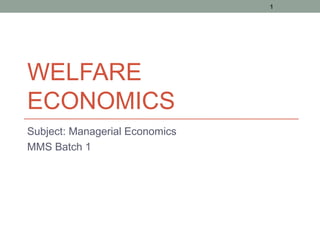
Welfare Economics Explained
- 2. 2 What is it? • Branch of economics concerning “Social Welfare” • Concepts • Demand curve • Supply curve • Consumer and producer surplus
- 3. 3 Measuring the gain from trade for consumers • Demand curve = marginal value curve • Total value for consumers toP purchase q units at price pd is S the area underneath the demand curve • Total expenditure for consumers to purchase q pd p units at price pd equals pd *q. • Consumer’s surplus (CS) D CS = Total Value –Expenditure the area between the q Q demand curve and the price line
- 4. 4 Measuring the gain from trade for producers • Supply curve is the marginal cost curve • The total variable cost for P the supplier to produce q S units of output at price ps is the area underneath of the supply curve ps • The total revenue for the producer to produce q units of output at price ps equals ps*q D • Producer’s surplus (PS) q Q PS=Total revenue - VC
- 5. 5 Dead Weight Loss • A gain that could have been created but weren’t. • A reduction in social gain because of policy intervention. • The tax policy is not efficient in the sense that social gain can be increased by dropping the tax.
- 6. 6 Price Control • What is price control • Price ceiling and price floor • Binding and non-binding price floor/ceiling • Examples • Price floor- Agricultural products • Price ceiling- Life-saving drugs
- 7. 7 The Invisible Hand • Competitive equilibrium without government intervention is often to be the most efficient. • The invisible hand theorem essentially says that “in competitive markets, people who selfishly pursue their own interests end up achieving an outcome that is socially desirable.”
- 8. 8 Externalities • What are externalities? • Types- • Positive Externality • Negative Externality • Government can affect the outcome of an activity by its policies. Example: Exhaust from automobiles, restored historic buildings • Negative externality (eg: Aluminium market) and positive externality (eg: Education) w.r.t to the demand supply curve
- 9. 9 Arthur Cecil Pigou (1877-1959) • Marshall’s successor, master of neoclassical economics. • Chair of political economy at Cambridge from 1908 to 1943. • Takes a softer view toward a larger role government • 1920, The Economics of Welfare • Method • Makes case for income distribution • Theory of externalities
- 10. 10 Pigou Tax • Tax applied to market activities that generate negative externalities • Example- Tax on tobacco, alcohol, etc. • CSR (Voluntary)
- 11. 11 The Invisible Hand • Competitive equilibrium without government intervention is often to be the most efficient. • The invisible hand theorem essentially says that “in competitive markets, people who selfishly pursue their own interests end up achieving an outcome that is socially desirable.”
- 12. 12 The Compensation Principle • Decision rule used to select between alternate feasible ‘social states’ • “If there are net gains to any economic change sufficient to compensate any losers, then it should go ahead, regardless of whether or not the compensation is actually paid” • Welfare economics relates to cost-benefit analysis • Application to real life problems like free trade
- 13. 13 Case Study 1: The Compensation Principle • All clothing manufacturers shut shops in Italy • All items physically produced in Asia (ex. Roma, an Italian design house opening a manufacturing facility in India- 1,000 new jobs in India and 200 in Italy) • Italy is now a booming design industry and a regional hub of fashion design using IT- job creation • Both parties are better off in economic terms
- 14. 14 Case Study 2: Gasoline Tax • Gasoline heavily taxed • Reasons- • Traffic congestion • Accidents • Pollution • Consequences- • Conservation of fuel • Reduction in carbon footprint
- 15. Amartya Sen’s Contribution • Outstanding economic theorist • Nobel memorial prize (1998) • Utilitarian approach • Act consequantialism • Welfarism • Sum-ranking
- 16. 16 THANK YOU !
